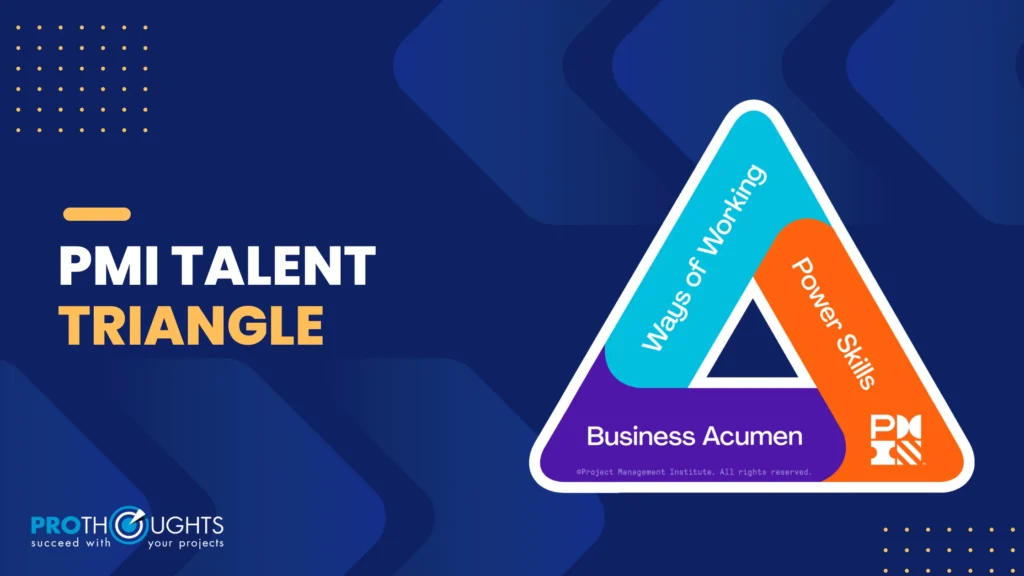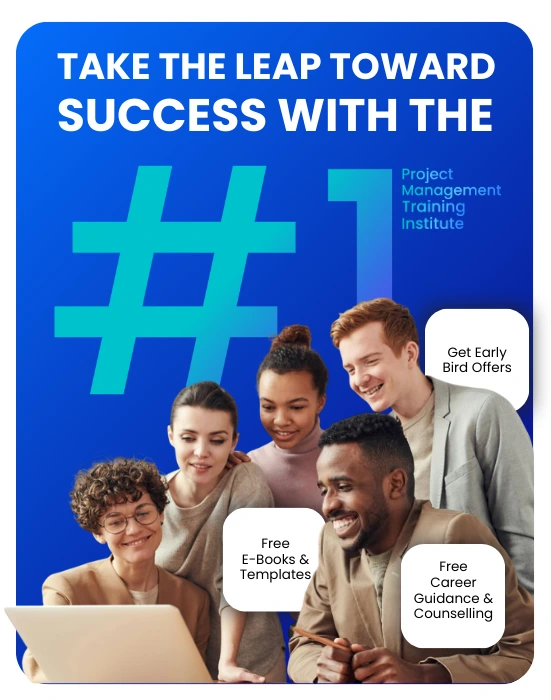
The PMI Talent Triangle is a structure created specifically for ongoing professional development. It helps professionals and practitioners like you to stay competitive in all the right ways! It includes the skills and abilities you must work on proactively and consistently to become a better project practitioner.
In fact, quite recently, this PMI Talent Triangle went through a revision to better match the needs of the current workplace. In this blog, we’ll look at the PDU categories in the Talent Triangle and how they’ll help you with professional development.
What is the PMI Talent Triangle?
The PMI Talent Triangle is a structure formed to help project managers upskill and rightly meet the demands of the workforce. It states that to excel in projects and align them with the objectives of the company, you require just the right blend of technical knowledge, leadership qualities, and a grasp of business strategy. These essential qualities formed the “sides” of the Talent Triangle.
Formerly, the skills in the PMI Talent Triangle or its “sides” were named as:
- Technical Project Management
- Leadership
- Strategic and Business Management
Right now, to match the current ways of working, the sides of PMI Talent Triangle are updated to be called:
- Ways of Working (formerly, Technical Project Management)
- Power Skills (formerly, Leadership)
- Business Acumen (formerly, Strategic and Business Management)
Components of the PMI Talent Triangle: Explained
The following three legs make up the PMI Talent Triangle, which encompasses the necessary methods for project governance:
1. Business Acumen:
Replacing “Strategic and Business Management”, this field includes skills like analyzing competitors and making choices that match the company’s goals. Furthermore, it focuses on knowing the strategic goals of a company and how projects fit into the bigger picture of business.
Business Acumen skills are essential in project management because a project manager who has strong business management knowledge can make planned and smart decisions that protect the projects from any discrepancies.
What’s Included in the Business Acumen category?
- Benefits Management and Realization
- Business Models and Structures
- Competitive Analysis
- Customer Relationships and Satisfaction
- Industry Domain Knowledge
- Legal and Regulatory Compliance
- Market Awareness
- Function-Specific Knowledge
- Strategic Planning, Analysis, Alignment
2. Ways of Working:
Formerly “Technical Project Management, this part stresses how important it is for project managers to learn a variety of project approaches, such as agile, predictive, and hybrid methods, so they can adapt to the needs of each project.
Ways of Working is important as it gives project managers the power to handle a number of methodologies and adapt to a variety of situations, both of which are vital working skills for project management. Teams must work well together even though they frequently use different methods or strategies.
A project manager who wants to advance in their career must be flexible, regardless of the strategy their organization employs. Additionally, different projects call for different strategies, so knowing when and how to apply the most effective one is essential.
What’s Included in the Ways of Working?
- Agile and Hyper Agile
- Hybrid
- Design Thinking
- Transformation
- Data Gathering and Modeling
- Earned Value Management
- Governance
- Performance Management
- Requirements Management and Traceability
- Risk Management
- Schedule Management
- Scope Management
- Time, Budget, and Cost Estimation
3. Power Skills
Previously termed “Leadership”, this includes important interpersonal skills like communication, teamwork, and emotional intelligence that project managers require to effectively lead and influence various teams.
Power Skills are important to accomplish the project’s goals, the team and project manager must persuade stakeholders, comprehend client expectations, and collaborate well via adjustments. These abilities guarantee that everyone collaborates effectively to meet the project’s objectives, even when things change.
To achieve the project’s objectives, the team and project manager need to convince project stakeholders, understand client expectations, and collaborate effectively even after there are changes in plans. This ensures that, despite any obstacles, everyone is committed and cooperating to achieve the company’s objectives.
What’s Included in the Power Skills?
- Leadership
- Active Listening
- Communication
- Adaptability
- Brainstorming
- Coaching and Mentoring
- Conflict Management
- Emotional Intelligence
- Influencing
- Interpersonal Skills
- Negotiation
- Problem-Solving
- Teamwork
How To Earn PDUs as per the PMI Talent Triangle
To maintain certifications such as PMP under the Continuing Certification Requirements (CCR) scheme, PMI PDUs (Professional Development Units) are essential. These courses ensure that project managers contribute to their field and stay up to date with evolving industry standards. Earning PDUs is possible in several ways. Here are some strategies you can use to remain active.
1. Education PDUs
Education PDUs are obtained through gaining new skills and expanding one’s knowledge. These closely correspond to the three PMI Talent Triangle pillars:
- Ways of Working: Discusses technical project management techniques, tools, and abilities.
- Power Skills: Included are team motivation and stakeholder communication, both interpersonal and leadership.
- Business Acumen: Emphasizes domain-specific and strategic knowledge, including decision-making frameworks and market trends.
Ways to Earn Education PDUs:
- Courses and Workshops: Participating in formal learning events or training sessions approved by PMI. ProThoughts provides free project management training that qualifies for PDUs if you hold a project management certification. Our online training videos are a useful tool whether you’re trying to gain extra continuing education credits, interested in project management, or seeking certification.
- Online Learning: Accessing webinars, on-demand videos, and PMI’s eLearning modules.
- Self-Directed Learning: Reading project management books or articles, watching tutorials, or studying case studies.
- PMI Events: Participating in conferences, symposiums, or PMI chapter meetings.
The Education category requires a minimum of 35 PDUs to ensure certification renewal gives more importance to continuous learning and skills development.
2. Giving Back PDUs:
Giving Back PDUs place a strong emphasis on knowledge application and contributions to the field of project management. Furthermore, professionals can share their knowledge, help others grow, and improve their abilities through experience in this category.
Ways to Earn Giving Back PDUs
- Work as a Practitioner: Utilizing project management skills at work or on freelance projects.
- Creating Content: Blog writing, making training materials, or designing webinars.
- Mentoring and Volunteering: Volunteering with PMI chapters, advising coworkers, or serving as a mentor to aspiring project managers.
- Presentations: Giving presentations or discussions at industry gatherings and conferences.
This category allows for the earning of up to 25 PDUs, which reflects PMI’s emphasis on striking a balance between learning and contributing.
How To Report PDUs to PMI?
By classifying the amount of time spent on various components, this section assists in breaking down the structure of a training session when submitting Professional Development Units (PDUs).
By analyzing the duration spent on Business Acumen, Ways of Working, and Power Skills, you can easily determine how each aspect contributes to the overall learning experience. Here’s how to calculate and allocate the time effectively.
Here’s the explanation:
1. Total Duration: Begin by stating how long the training or activity will last overall (e.g., 6 hours).
2. Business Acumen (BA): Determine the extent to which the training concentrated on abilities such as financial analysis, strategic planning, and business environment comprehension. Subtract this time from the total.
For example, 2 hours spent on Business Acumen then 6 hours – 2 hours = 4 hours left.
3. Ways of Working (WOW): Calculate how much of the remaining time was devoted to technical project management techniques, tools, or approaches such as risk management, Agile, or Scrum. Subtract this time.
For example, 3 hours spent on Ways of Working then 4 hours – 3 hours = 1 hour left.
4. Power Skills (PS): Lastly, find out how much time was devoted to soft skills like teamwork, communication, and leadership. This category should include the remaining time.
For example, 1 hour spent on Power Skills → All time accounted for.
This breakdown helps you allocate the training hours to the appropriate categories when reporting to PMI to maintain your certification.
How is the PMI Talent Triangle Important?
-
Certification Renewal
If you are a PMP, for example, you must earn 60 PDUs every three years to keep your certification valid. The necessary balance is:
- Minimum of 35 PDUs in Education.
- Maximum of 25 PDUs in Giving Back.
This framework guarantees that professionals devote enough time to learning new things and making contributions to their field. On earning these 60 PDUs you can successfully renew your PMI- PMP certification. Similarly, other PMI certifications have different PDU breakdowns as per types and components.
👉 Word of Advice
The requirements for PDUs are quite a lot to earn at once. So, the one thing you should avoid is waiting until the last minute to earn the PMI PDU credit required to maintain your certification. It is always better to plan ahead and set reminders.
These reminders ensure you don’t forget or wait for the last moment to complete your required PDUs for your certification maintenance.
Keep an eye out for our webinars to have your PDU schedule in check!
-
Staying Updated
What happens if you don’t stay up to date with industry trends for project managers? You may get out of date and be less effective. That’s where PMP PDUs come into the picture. PMI makes sure that you stay informed and prepared for developments in the market as well as best practices. You and the projects you are working on would benefit from this.
Being informed and having current knowledge of the latest market scenarios, will help you improve your performance and achieve the best results. Ultimately advancing their careers and guaranteeing that the projects they work on are successful and up to date. Both the professionals and the projects they oversee gain from ongoing education!
Conclusion
Learning is a journey that will never stop, just like project management. The certification or degree is only the beginning. Technology and innovation-spurring techniques will always improve, and staying updated with the knowledge and skills is important for your growth in this field.
Thus, by reading this blog you might have got a clear idea of PMP Renewal PDUs and how to earn it. This makes sure that you are updated with the recent news and articles in the market. In addition to keeping your PMP certification, earning PDUs becomes more beneficial for you, which makes you more desirable to employers. Keep a goal in mind and work on it with determination. Best wishes!




